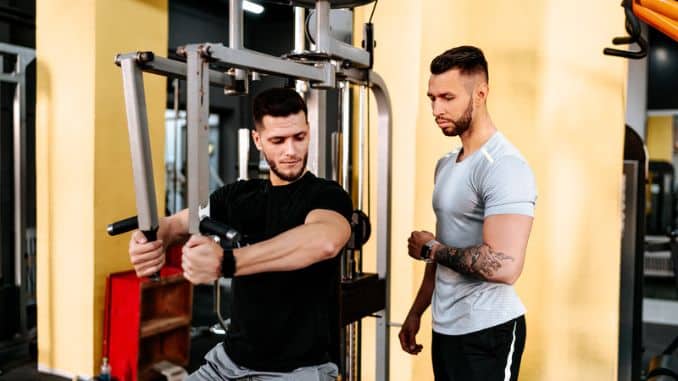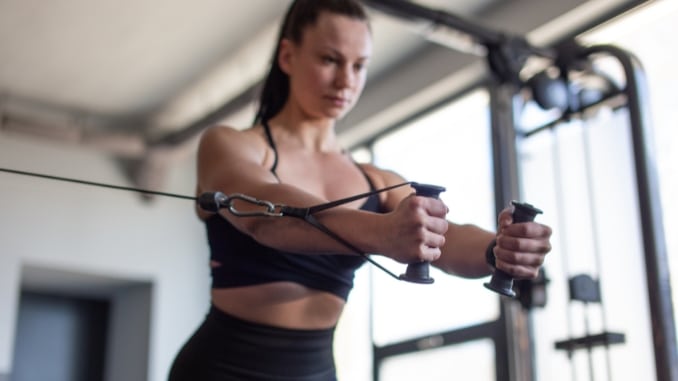Hey there, fitness enthusiasts!
I’ve been there too—trying to build a stronger chest with cable pec flys but ending up with nagging shoulder pain. It’s frustrating when you’re trying to improve your fitness but hurting instead.
I wanted to share tips and techniques to help you perform cable pec flys safely and effectively. We’ll cover everything from proper form to injury prevention so you can keep your workouts pain-free and productive.
Cable flies are a fantastic exercise technique for targeting our chest muscles. Using cables allows for a greater range of motion than traditional free weights. But, like any exercise, it’s important to do it correctly to avoid injuries.
Proper Cable Pec Fly Form with Elbows Slightly Bent for Shoulder Health
- Set the Pulley Height: Make sure the pulleys are at shoulder height.
- Position Your Body: Stand with one foot forward, knees slightly bent, and lean forward slightly.
- Grasp the Handles: Hold the handles with your palms facing each other and arms slightly bent.
The chest fly is a significant exercise in strength training, particularly when performing the cable chest fly. Keep your shoulder blades stable, and avoid shrugging your shoulders. This setup helps protect our shoulders from strain.
According to Shaheen Jadidi, DO, “the shoulder is not a weight-bearing joint like the knee or hip, but its complex anatomy and small muscles are exposed to accelerated wear. Holding a pound of weight and moving it away from the body adds ten times the force to the shoulder.”
Mastering Proper Technique for Chest Muscles
Mastering proper technique for chest muscles is crucial for achieving optimal results and preventing injuries.
When performing chest exercises, it’s essential to focus on proper form and technique to ensure that you’re targeting the correct muscles and avoiding unnecessary strain on your shoulders and joints.
To start, always keep your elbows slightly bent to reduce tension on the shoulder joint. This small adjustment can significantly affect how the exercise feels and how effective it is.
Additionally, slightly arching your back can help engage your chest muscles more effectively while keeping your shoulders safer.
Remember, the goal is to feel the contraction in your chest, not your shoulders. If your shoulders take over, it might be a sign that you need to adjust your form or reduce the weight.
Consistency in maintaining proper form will lead to better muscle development and less risk of injury.
Avoid Shoulder Pain During Cable Pec Fly

Common mistakes can lead to shoulder pain. Here’s what we need to avoid:
- Using too much weight can lead to injuries and improper technique.
- Incorrect hand positioning.
Start with lighter weights and focus on higher reps to perfect your form.
Here’s a pro tip from fitness experts: Engage your core and control your movements.
Fixing Cable Pec Fly Shoulder Tuck Mistake
One mistake many of us make is tucking our shoulders too much. This can cause pain and strain. Instead, keep your chest up and shoulders back.
This keeps the tension on the chest muscles [1] and off our shoulders. Experts suggest visualizing squeezing a pencil between your shoulder blades.
Best Form for Cable Pec Fly Exercise

Getting the best form is key.
- Stand in the middle of the cable machine, feet shoulder-width apart.
- Engage your core and move your arms in a controlled manner. Variations like adjusting the angle can target different parts of the chest.
Try different angles to see what feels best for your body.
Tips and Techniques to Address Shoulder Pain During Cable Fly Exercises
- Warm-Up Properly: Always start with dynamic stretches and light cardio to increase blood flow and loosen the shoulder joint.
- Check Your Form: Maintain a slight bend in the elbows and avoid overextending the arms during the movement to reduce strain on the shoulder joint.
- Use Lighter Weights: Heavier weights can cause excessive strain; focus on form and controlled movement instead of load.
- Adjust Cable Height: Set the cables at chest level or slightly below to avoid excessive upward or downward stress on the shoulders.
- Limit Range of Motion: Do not overstretch during the eccentric (stretching) phase of the fly. Keep the movement within a comfortable range.
- Engage Core Muscles: Stabilize your body by engaging your core, reducing unnecessary strain on the shoulders.
- Strengthen Supporting Muscles: Incorporate exercises that strengthen the rotator cuff, rear deltoids, and scapular stabilizers.
- Stretch and Mobilize: Perform shoulder stretches and mobility drills to improve flexibility and joint health.
- Modify Grip and Positioning: Experiment with a neutral grip (palms facing each other) and avoid locking your shoulders forward.
- Stop if Pain Persists: Persistent pain may indicate an injury or improper technique. Rest, evaluate your form, and consult a professional if needed.
Integrating Cable Pec Flys into Your Workout Routine

Cable pec flies are a versatile exercise that can be integrated into your workout routine to target your chest muscles from different angles.
Here are some tips for incorporating cable pec flys into your training plan:
First, consider where cable pec flys fit best in your workout. They can be an excellent addition to your chest day and full-body workouts.
Start with lighter weights to warm up your chest muscles, then gradually increase the weight as you become more comfortable with the movement.
Experiment with different angles by adjusting the height of the pulleys. High-to-low cable flys can target the lower chest, while low-to-high flys can emphasize the upper chest.
This variety keeps your workouts interesting and ensures comprehensive muscle development.
Lastly, balance your routine with other chest exercises like bench presses and push-ups. This approach helps prevent muscle imbalances and promotes overall chest strength and stability.
Advanced Training Considerations
Advanced training considerations [2] for chest muscles involve incorporating more complex exercises and techniques into your workout routine. Here are some tips for advanced training:
As you progress, you should challenge yourself with heavier weights or more advanced variations of the cable pec fly.
For instance, try performing the exercise on one leg to engage your core and improve balance. This not only intensifies the workout but also enhances overall muscle coordination.
Another advanced technique is to incorporate drop sets. Start with a heavier weight and perform as many reps as possible with proper form. Then, reduce the weight and continue the exercise without resting.
This method can help push your muscles to their limits and stimulate growth.
Always remember to listen to your body. Advanced training can be demanding, so it’s crucial to avoid overtraining.
Ensure you have a well-rounded training plan that includes adequate rest and recovery. This balance will help you achieve your fitness goals while minimizing the risk of injury.
These advanced training tips can take your chest workouts to the next level, ensuring continued progress and muscle development.
Conclusion
Performing cable pec fly with proper form is essential to avoiding shoulder pain [3] and maximizing your workout’s effectiveness.
Remember to take preventive measures, warm up properly, and start with lighter weights.
Consistency and listening to your body are key to staying injury-free. So, let’s conquer those cable pec flys together, pain-free. If you have any questions or need more advice, please ask!
Shoulder pain has multiple causes and it needs multiple treatment methods.
But there’s a fast and effective solution for this. Check out this Shoulder Pain Solved now!
Frequently Asked Questions
Why does my shoulder hurt on cable fly?
Shoulder pain during cable pec fly can occur due to overworking the deltoids, improper form, or underlying shoulder issues like impingement or rotator cuff injuries. It’s important to ensure you’re using the correct form and not overloading your muscles.
Are cable flys good for shoulders?
Yes, cable flys can be good for shoulders as they help build strong, powerful shoulders by targeting all three deltoid muscles from different angles. However, it’s crucial to use proper form to avoid injury1.
Can I still work out with shoulder pain?
It depends on the severity of the pain. If the pain is mild, you can perform low-impact exercises or stretches. However, if the pain is severe or persistent, it’s best to rest and consult a healthcare professional before continuing your workout routine.


